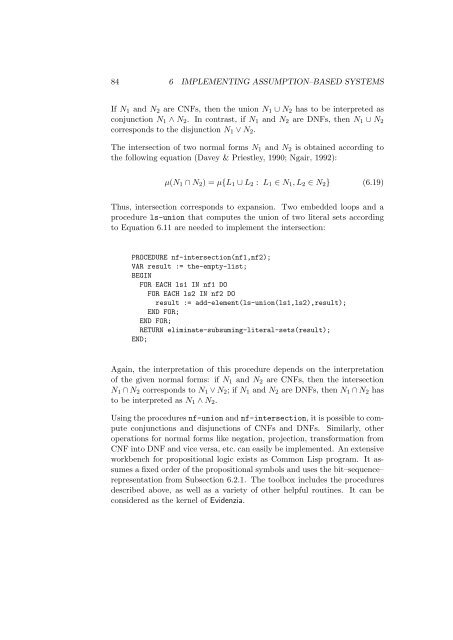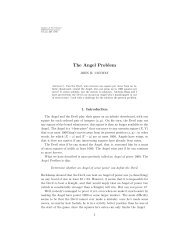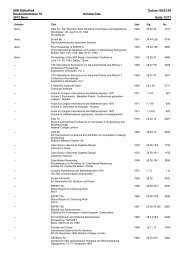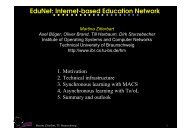Propositional Argumentation Systems and Symbolic Evidence Theory
Propositional Argumentation Systems and Symbolic Evidence Theory
Propositional Argumentation Systems and Symbolic Evidence Theory
Create successful ePaper yourself
Turn your PDF publications into a flip-book with our unique Google optimized e-Paper software.
84 6 IMPLEMENTING ASSUMPTION–BASED SYSTEMS<br />
If N 1 <strong>and</strong> N 2 are CNFs, then the union N 1 ∪ N 2 has to be interpreted as<br />
conjunction N 1 ∧ N 2 . In contrast, if N 1 <strong>and</strong> N 2 are DNFs, then N 1 ∪ N 2<br />
corresponds to the disjunction N 1 ∨ N 2 .<br />
The intersection of two normal forms N 1 <strong>and</strong> N 2 is obtained according to<br />
the following equation (Davey & Priestley, 1990; Ngair, 1992):<br />
µ(N 1 ∩ N 2 ) = µ{L 1 ∪ L 2 : L 1 ∈ N 1 , L 2 ∈ N 2 } (6.19)<br />
Thus, intersection corresponds to expansion. Two embedded loops <strong>and</strong> a<br />
procedure ls-union that computes the union of two literal sets according<br />
to Equation 6.11 are needed to implement the intersection:<br />
PROCEDURE nf-intersection(nf1,nf2);<br />
VAR result := the-empty-list;<br />
BEGIN<br />
FOR EACH ls1 IN nf1 DO<br />
FOR EACH ls2 IN nf2 DO<br />
result := add-element(ls-union(ls1,ls2),result);<br />
END FOR;<br />
END FOR;<br />
RETURN eliminate-subsuming-literal-sets(result);<br />
END;<br />
Again, the interpretation of this procedure depends on the interpretation<br />
of the given normal forms: if N 1 <strong>and</strong> N 2 are CNFs, then the intersection<br />
N 1 ∩ N 2 corresponds to N 1 ∨ N 2 ; if N 1 <strong>and</strong> N 2 are DNFs, then N 1 ∩ N 2 has<br />
to be interpreted as N 1 ∧ N 2 .<br />
Using the procedures nf-union <strong>and</strong> nf-intersection, it is possible to compute<br />
conjunctions <strong>and</strong> disjunctions of CNFs <strong>and</strong> DNFs. Similarly, other<br />
operations for normal forms like negation, projection, transformation from<br />
CNF into DNF <strong>and</strong> vice versa, etc. can easily be implemented. An extensive<br />
workbench for propositional logic exists as Common Lisp program. It assumes<br />
a fixed order of the propositional symbols <strong>and</strong> uses the bit–sequence–<br />
representation from Subsection 6.2.1. The toolbox includes the procedures<br />
described above, as well as a variety of other helpful routines. It can be<br />
considered as the kernel of Evidenzia.








